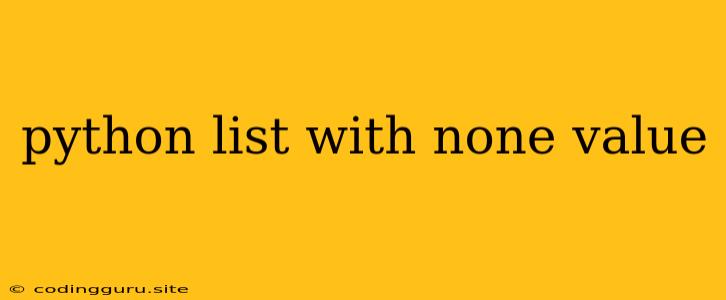Dealing with None Values in Python Lists
Python lists are versatile data structures that allow you to store a collection of items. Sometimes, you might encounter situations where your list contains None values. This can happen when you're working with data from external sources, processing data with loops, or even as a result of specific logic within your program.
Understanding how to handle None values within Python lists is crucial for ensuring the correct operation and integrity of your code. In this article, we'll explore various scenarios involving None values in Python lists and provide tips and solutions to effectively manage them.
Why Do None Values Appear in Lists?
Let's first delve into common reasons why you might find None values in your Python lists:
1. Default Initialization: When you initialize a list with a specific length, the elements might default to None:
my_list = [None] * 5 # Creates a list of 5 'None' values
print(my_list) # Output: [None, None, None, None, None]
2. Data Loading: If you're loading data from external sources like files or databases, some entries might be missing or have None as their placeholder.
3. Conditional Operations: When you use conditional statements to populate a list, certain conditions might not be met, leading to None values being inserted.
4. Function Return Values: Functions might return None if they fail to produce a result or are designed to handle missing data gracefully.
Managing None Values: A Comprehensive Guide
Now, let's dive into methods for dealing with None values within your Python lists.
1. Removing None Values:
filter(): This built-in function allows you to apply a condition to filter out undesired elements from a list.
my_list = [1, 2, None, 4, None, 6]
filtered_list = list(filter(None, my_list))
print(filtered_list) # Output: [1, 2, 4, 6]
- List Comprehension: A more concise way to remove
Nonevalues using list comprehensions:
my_list = [1, 2, None, 4, None, 6]
filtered_list = [x for x in my_list if x is not None]
print(filtered_list) # Output: [1, 2, 4, 6]
2. Replacing None Values:
map(): This function applies a specified function to each element of the list. You can use it to replaceNonevalues with a desired value.
my_list = [1, 2, None, 4, None, 6]
replaced_list = list(map(lambda x: 0 if x is None else x, my_list))
print(replaced_list) # Output: [1, 2, 0, 4, 0, 6]
- List Comprehension: Using list comprehensions for replacement:
my_list = [1, 2, None, 4, None, 6]
replaced_list = [0 if x is None else x for x in my_list]
print(replaced_list) # Output: [1, 2, 0, 4, 0, 6]
3. Counting None Values:
count(): You can directly count the number ofNonevalues in your list:
my_list = [1, 2, None, 4, None, 6]
none_count = my_list.count(None)
print(none_count) # Output: 2
4. Handling None Values in Operations:
- Conditional Statements: Use
ifstatements to handle operations differently when encounteringNone:
my_list = [1, 2, None, 4, None, 6]
for item in my_list:
if item is not None:
print(item * 2)
else:
print("None value encountered")
- The
orOperator: This allows you to provide a default value if the original value isNone:
my_list = [1, 2, None, 4, None, 6]
for item in my_list:
print(item or 0) # Prints the value or 0 if it's None
5. Identifying Indices of None Values:
enumerate(): Combineenumerate()with a loop to get both the index and value of each element.
my_list = [1, 2, None, 4, None, 6]
for index, value in enumerate(my_list):
if value is None:
print(f"None value found at index: {index}")
Best Practices for Handling None Values in Python Lists
- Be Aware of
None: Always be mindful of potentialNonevalues, especially when working with external data or complex operations. - Avoid Assumptions: Don't assume that
Nonevalues will always be handled implicitly. Use explicit checks and appropriate techniques to manage them effectively. - Document Your Approach: If your code involves handling
Nonevalues, document your strategies clearly for maintainability. - Choose the Right Method: Select the most suitable method for managing
Nonevalues based on your specific requirements and context.
Conclusion
Understanding and effectively handling None values in Python lists is essential for building robust and reliable code. This article has explored common scenarios, provided various methods for managing None values, and outlined best practices to ensure your code handles these special cases gracefully. By applying these tips and strategies, you can write clean, efficient, and error-free Python programs that handle None values with ease.
